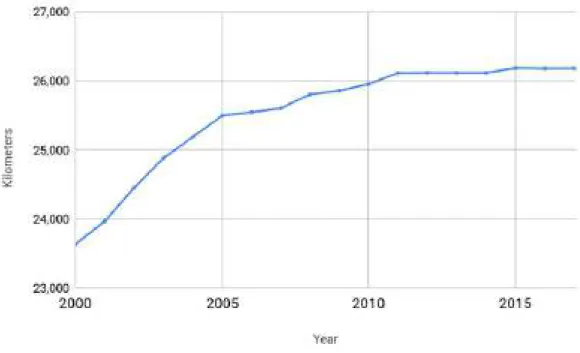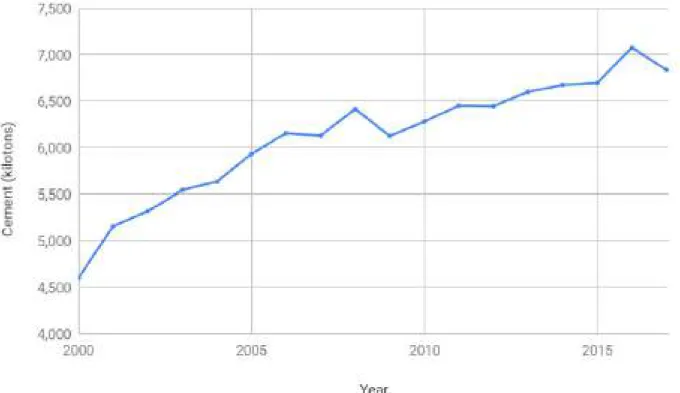However, this was by no means the first catastrophic accident in which many people were killed and injured in the DPRK. In this study, we seek to assess the current burden of traumatic injuries in the DPRK and analyze the capacity for injury care to treat them. Finally, we propose a roadmap for multilateral assistance to strengthen the personal injury system in the DPRK.
In summary, these data provide a likely picture of the overall injury burden in the DPRK. We researched the international medical literature as well as gray literature on the healthcare system in the DPRK and its capacity for injury care.
![Figure 1. Top Ten Causes of Death in the DPRK [Data Source: WHO]](https://thumb-eu.123doks.com/thumbv2/pubdocnet/373010.44427/6.918.151.711.358.695/figure-causes-death-dprk-data-source.webp)
CONSTRUCTION BOOM
Numerous high-rise buildings are visible on Ryomyong Complex, a massive real estate project in which hundreds of high-rise buildings were ordered to be built in just one year to showcase the efficiency of the government. It is a prestigious residential area where the construction of three 47-story buildings and 15 other high-rise buildings has been completed in less than a year.23 New apartments have been completed in the Mirae Scientists' Street.24 Public buildings and cultural complexes have also been completed in recent years, including the Mansudae People's Munci Theater, Pynci-Techongyang Airport, Pynci-Techongyang and Waterpark5. These are valid concerns in the context of injury burden, considering the fact that many construction projects carried out in the DPRK have been plagued by both minor and major accidents such as falls, collapses and collapses.

PROJECTIONS USING THE MYANMAR MODEL
Tourism Boom
The construction boom in the DPRK has come together with remarkable growth in the tourism sector in recent years. It has actively encouraged citizens to support the initiative, as seen on propaganda posters (Figure 10).35 Satellite images of the coast throughout 2018 show that at least 170 new high-rise buildings plus an artificial lake are being built at breakneck speed over a construction area that stretches more than 4.5 km in length. DPRK has ever launched. 50-60,000 Chinese tourists visited the DPRK that year39, there clearly seems to have been a drastic increase in tourist traffic to the country.
According to unreliable evidence, recent developments on the Korean Peninsula have also led to an influx of tourists, particularly from China and Russia, to the extent that the government plans to limit the number of visitors to 1,000 per day.40,41 Incredibly, NGO workers who regularly visit the DPRK also report that it is becoming increasingly difficult to book airline tickets in and out of the country. As these recent developments suggest, the DPRK could reach its goal of welcoming two million tourists by 2020.44 The increase in foreign tourists and the injuries associated with more visits will undoubtedly test the DPRK's ability to provide medical care when needed.
If the DPRK does not invest in strengthening personal injury care, the enthusiasm for traveling to the DPRK could decrease. But negative perceptions of the DPRK as a tourist destination due to the inability to provide adequate injury care will undoubtedly have a negative effect on tourist numbers. It is likely that tourism and investment flows to the DPRK will mirror those of Myanmar as the country gradually opens up to the world.
But the case of Myanmar illustrates that tourism numbers are highly influenced by the political situation of a country as well as its perception abroad, which is also likely to play a role in the ability of the DPRK to attract tourists in the coming years.

Road Traffic Increase
An underdeveloped system for the care of the injured would constitute a limit to the potential growth of tourism. For the three observed areas, a clear increase in the number of vehicles can be found, as can be seen from the trend lines. As a next step, to derive the percentage growth of all three areas, they were presented in a single graph (Figure 19).
The percentage increase of the combined and normalized trend for all three measurements between 2000 and 2018 is 817.8%.52. It is known that in many respects, cities and rural areas outside Pyongyang are less developed than the capital. This also affects traffic outside of Pyongyang, as private car ownership as well as business-related traffic is higher in the capital.
Furthermore, the baseline is rather high, since the first available satellite images are from more recent dates (2007 for Hamhung and 2013 for Rason), while the increase would probably be more visible if data from the early 2000s were available, as is the case for our measurements for Pyongyang. The percentage increase of the combined and normalized trend for both measurements between 2007 and 2019 is 59.3%.53 In summary, it can be said that traffic in the DPRK has increased over the past two decades. Based on these measurements and calculations, it is possible not only to see the development of road traffic in the DPRK, but also to estimate how traffic will continue to increase if the DPRK remains on the current path of limited engagement with the rest of the world and with the current sanctions regime in place or only slightly changed.
To assess the potential increase in traffic in an opening scenario in the near future, the next section will again use Myanmar as a model and collect data on traffic developments in the country after opening in 2010.
![Figure 13. Satellite Data Source 1 Example Image: Seungri Street in Pyongyang, 23 April 2017 [Source: Google Earth Pro]](https://thumb-eu.123doks.com/thumbv2/pubdocnet/373010.44427/20.918.136.777.141.597/figure-satellite-source-example-seungri-street-pyongyang-source.webp)
27Projections Using the Myanmar Model
Multi-national Industrial and Infrastructure Projects
After establishing the increased injury burden that can be expected in the near future based on data from the DPRK as well as on projections from Myanmar, this section will introduce the potential contribution of multinational projects in the. For the ROK, the benefits of increased connectivity in the region are high: the ROK is the 13th largest economy in the world and a major global manufacturer.58 However, the ROK has virtually no natural resources, which means that raw materials and fossil fuels must be shipped into the country while finished goods must be shipped. Trans-Korean railways as well as oil and gas pipelines from the Asian mainland through the DPRK to the ROK are examples of potential projects.59,60.
The 2018-19 summit, with Kim Jong-un holding meetings with President Moon Jae-in and President Donald Trump, among others, was seen as a sign of impending changes on the Korean Peninsula. The document, which resulted from the first meeting between the leaders of the two Koreas, proposed the modernization of railways and roads in the east via Wonsan as well as in the west between Seoul and Sinuiju.61 In November 2018, the ROK sent a train expedition to the DPRK that included engineers and planners for a fact-finding tour. Besides infrastructure development in the border regions, North Korean Special Economic Zones (SEZs) have been the primary area of interest for multinational infrastructure and industrial projects since Kim Jong-un took power.
Laws and regulations in the zones are friendly to foreign investors and differ from the rest of the country.63 In 2015, the number of foreign companies investing in the SEZs was 129.64 The ability to supply electricity from China directly to the foreign companies in the SEZs was planned in 2013,65 but progress in this area could not be verified to date. In short, all three of the DPRK's neighbors are pushing for closer economic cooperation and infrastructure integration in the region. While China and Russia have decades of experience of cooperating on cross-border projects along the northern border of the DPRK, including through SEZs, the ROK's past activities have been limited to the Kaesong Industrial Complex and isolated tourism projects.
However, a more holistic approach to DPRK development is possible under the current administration.
MACROECONOMICS OF INJURY CARE
- ECONOMIC AND SOCIETAL COSTS DUE TO INJURIES IN THE DPRK
Based on the multinational infrastructure and industrial projects observed so far, which are clearly growing in number, we can also expect an increasing need for trauma processing capacity. Values used to calculate the economic burden of disability-adjusted life years (DALYs) due to injuries in the DPRK.
31Table 1. Values Used to Calculate the Economic Burden of Disability-Adjusted Life Years (DALYs) Due to Injuries in the DPRK
ECONOMIC COST IF THE DPRK FAILS TO PREPARE IN 5 YEARS
ROAD MAP FOR SCALING UP INJURY CARE CAPACITY IN THE DPRK
- Operationalizing Injury Care Within the Medium Term Plan for Development of the Health Sector in 2016-2020
- Financing of Injury Care Capacity Scaling Up
- Scaling Up of Injury Care Capacity under the Current Political Context
This would allow North Koreans throughout the DPRK to benefit from increased injury care capacity. Simply put, the DPRK lacks the financial resources to cover the costs of expanding its trauma care system. Therefore, KPRK can realistically cover these costs only through co-financing and/or external financing.
Two cases serve to illustrate the DPRK's use of co-financing in the healthcare sector. Another case that illustrates the DPRK's use of co-financing is its work with the Global Fund. The Eugene Bell Foundation is an example of a non-profit organization working in the healthcare sector in the DPRK.
In addition, the opening of the DPRK, if realized, will certainly attract more foreign tourists and labor. Foreign companies investing in the DPRK are very likely to send workers from abroad to work alongside local employees. The question is whether the DPRK can build its trauma care system before opening up due to the current sanctions regime.
As the Office of the UN Resident Coordinator in the DPRK makes clear, robust implementation, coordination and monitoring mechanisms are in place.
CONCLUSION
ENDNOTES
26 Colin Zwirko, “Shoddy Construction on Display at Sinuiju Riverside High-Rise Construction Site,” NK News, April 16, 2019, https://www.nknews.org/. 67 Anna Fifield, “Cash-Strapped North Korea Steps Up Mining Output,” Washington Post, February 28, 2015, https://www.washingtonpost.com/. 71 World Bank, The High Toll of Traffic Injuries: Unacceptable and Preventable (Washington, DC: World Bank, 2017), https://www.worldbank.org/en/.
80 The Global Fund, Global Fund Overview, The Global Fund to Fight AIDS, Tuberculosis and Malaria, 2019, www.theglobalfund.org/en/overview. 82 The Global Fund, Country Overview: DPRK, The Global Fund to Fight AIDS, Tuberculosis and Malaria, 2019, www.theglobalfund.org/en/portfolio/. 85 Eugene Bell Foundation, Geschiedenis, Eugene Bell Foundation, 2019, http://www.eugene-bell.org/our-story/history/.
87 United Nations Security Council, Letter of approval of exemption request, 21 January 2019, https://www.un.org/securitycouncil/sites/. 93 United Nations Security Council, Humanitarian Exception Requests, United Nations, 2019, https://www.un.org/securitycouncil/sanctions/1718/. Department of the Treasury, North Korea Sanctions, 2019, https://www.treasury.gov/resource-center/sanctions/programs/pages/nkorea.
Will Review North Korea Travel Ban, Says Envoy,” The New York Times, 20 Dec. 2018, https://www.nytimes.
PROGRAM IN GLOBAL SURGERY AND SOCIAL CHANGE HARVARD MEDICAL SCHOOL
![Figure 2. Causes of Death in the DPRK by Age [Data Source: WHO]](https://thumb-eu.123doks.com/thumbv2/pubdocnet/373010.44427/6.918.163.711.799.1113/figure-causes-death-dprk-age-data-source.webp)
![Figure 4. Mechanism of Injury Deaths [Data Source: WHO]](https://thumb-eu.123doks.com/thumbv2/pubdocnet/373010.44427/7.918.148.754.160.520/figure-mechanism-injury-deaths-data-source.webp)

![Figure 7. Construction Zone near Ryomyong Street [Source: NK News]](https://thumb-eu.123doks.com/thumbv2/pubdocnet/373010.44427/12.918.110.842.764.1114/figure-construction-zone-near-ryomyong-street-source-news.webp)
![Figure 9. Sinuiju High-Rise Building [Source: NK News]](https://thumb-eu.123doks.com/thumbv2/pubdocnet/373010.44427/13.918.129.796.150.466/figure-sinuiju-high-rise-building-source-nk-news.webp)
![Figure 11. Active Construction Sites in the Wonsan-Kalma Tourism Complex [Source: NK News]](https://thumb-eu.123doks.com/thumbv2/pubdocnet/373010.44427/16.918.54.865.800.1113/figure-active-construction-sites-wonsan-tourism-complex-source.webp)
![Figure 12: Tourist Arrivals in Myanmar, 1990-2017 [Source: UNWTO]](https://thumb-eu.123doks.com/thumbv2/pubdocnet/373010.44427/18.918.61.835.199.553/figure-tourist-arrivals-myanmar-source-unwto.webp)